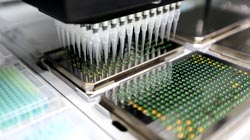Researchers Gain Fuller Picture of Cell Protein Reactions

Northwestern researchers have used a process called SAMDI mass spectrometry to analyze the enzyme reactions within cells.<br>
Over the past decade, advances in genetic mapping tools have provided great insight into how DNA influences cell behavior. But genetics is only half the equation; much of cells’ behavior is the result of post-transcriptional processes, events that occur after DNA is transcribed, carried out by complex enzyme interactions within the cell.
The roles that enzymes play in regulating cell behavior have been incompletely understood, largely because researchers have lacked the proper tools to measure the many simultaneous reactions in a cell.
Northwestern University researchers have recently developed a new technique for profiling enzyme activities in cell lysate, a fluid containing the internal contents of cells. The process uses surfaces that present an array of peptides that each interact with enzymes in a lysate. The changes the enzymes make to the peptides can be directly read using a laser to determine the changes in mass of those peptides.
A paper about the research, “Profiling Deacetylase Activities in Cell Lysates with Peptide Arrays and SAMDI Mass Spectrometry,” was published as an Editors’ Highlight in the November 19 issue of Analytical Chemistry.
William Miller, professor of chemical and biological engineering at Northwestern’s McCormick School of Engineering and Applied Science, initiated the project to find new methods for growing blood platelets in cultures. (Transfusions of platelets — tiny cells in the blood that promote clotting — can prevent complications from bleeding, but maintaining supplies of the cells is challenging because several donors are often required to collect one transfusion and samples must be used within days.)
Researchers can grow platelets by differentiating blood stem cells into megakaryocytes, the cells in bone marrow that produce platelets, but the process falls far short of nature. In humans, megakaryocytes undergo DNA replication without cell division to form giant cells that extend processes called proplatelets and produce thousands of platelets, but in culture they produce fewer than 10 because the cells do not get as large and many die before they release platelets.
In an earlier study, Miller and his collaborators found that inhibiting a certain family of enzymes helped promote differentiation, resulting in larger megakaryocytes and more extensive proplatelet formation.
Miller’s colleague, Milan Mrksich, the Henry Wade Rogers Professor of Biomedical Engineering, Chemistry, and Cell and Molecular Biology at McCormick, had been developing bioanalytical techniques for just this type of problem. The two partnered to profile a cell line model of the bone marrow cells that produce platelets.
“If we understand the enzyme activities that occur during megakaryocyte differentiation, it may be possible to prevent or promote differentiation for platelet production and other purposes,” Miller said.
Using Mrksich’s unique process of self-assembled monolayers desorption ionization (SAMDI) mass spectrometry, a super-fast, low-cost, and “label-free” method of measuring biochemical activities on a surface, the researchers were able to identify patterns of enzyme activities in cell lysates.
The researchers focused on histone deacetylase enzymes, a family of 17 enzymes that remove acetyl groups from certain proteins. They found that global deacetylase activity decreased significantly during differentiation, and that the decrease could be attributed to the sirtuin class comprising six deacetylases. The activities of the other 11 “classical” deacetylases did not substantially change.
Traditionally, discovering protein function has been a slow, tedious process of trial and error. Current methods use labels — chemical additives that leave their mark in a reaction, such as radioactivity or fluorescence — to determine whether a protein is active in a reaction. But labels can only test to see whether a specific reaction is occurring, which limits potential discoveries.
Using SAMDI mass spectrometry, the researchers separately tethered hundreds of different acetylated peptides to a gold-plated surface, then introduced lysate to see if a reaction would occur. When the reaction was complete, the plate was struck with a laser that released the peptides from the gold base. The contents of each site were weighed, allowing researchers to make an educated assumption about what occurred in each reaction.
“Until now, measuring the activity of enzymes in cell lysate has been a tremendous challenge because lysates contain tens of thousands of different molecules,” Mrksich said. “With SAMDI mass spectrometry, we can use arrays having thousands of peptides to identify those many activities, and through sophisticated analysis we obtain a global picture of how complex cell functions are regulated.”
In addition to Miller and Mrksich, other authors of the paper include co-first authors Hsin-Yu Kuo and Teresa A. DeLuca, both graduate students at Northwestern.
Media Contact
More Information:
http://www.northwestern.eduAll latest news from the category: Life Sciences and Chemistry
Articles and reports from the Life Sciences and chemistry area deal with applied and basic research into modern biology, chemistry and human medicine.
Valuable information can be found on a range of life sciences fields including bacteriology, biochemistry, bionics, bioinformatics, biophysics, biotechnology, genetics, geobotany, human biology, marine biology, microbiology, molecular biology, cellular biology, zoology, bioinorganic chemistry, microchemistry and environmental chemistry.
Newest articles

Silicon Carbide Innovation Alliance to drive industrial-scale semiconductor work
Known for its ability to withstand extreme environments and high voltages, silicon carbide (SiC) is a semiconducting material made up of silicon and carbon atoms arranged into crystals that is…

New SPECT/CT technique shows impressive biomarker identification
…offers increased access for prostate cancer patients. A novel SPECT/CT acquisition method can accurately detect radiopharmaceutical biodistribution in a convenient manner for prostate cancer patients, opening the door for more…

How 3D printers can give robots a soft touch
Soft skin coverings and touch sensors have emerged as a promising feature for robots that are both safer and more intuitive for human interaction, but they are expensive and difficult…





















